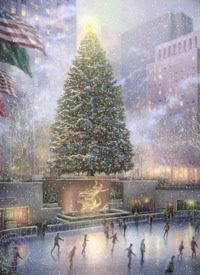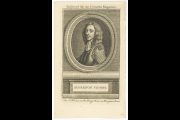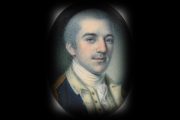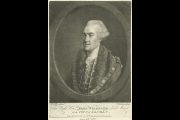
Kinkade, who described himself as the “Painter of Light,” once claimed that he was the nation’s most collected living artist, with limited editions of his works — along with mass-produced prints, calendars, books, coffee mugs, and sundry other items bearing his art — fetching his art business enterprise $100 million per year in sales, by one account. He once estimated that his paintings and spin-off products graced some 10 million homes in America.
“Though often disdained by the fine art establishment,” reported the New York Times, “Mr. Kinkade built a decorative art empire by creating sentimental paintings that were, for the most part, relatively inexpensive and resonated with the desires of homeowners who did not ordinarily buy art. He sold his work directly, through his own franchise galleries or on cable television home shopping networks, and eventually online.”
Later, Kinkade licensed his works to such companies as Avon and La-Z-Boy, to produce Thomas Kinkade lines of accessories and home furnishings. He even helped to design gated communities in California to which he lent his name, with homes and properties reflecting the artistic sensibilities of his paintings. “When Walt looked out over his citrus grove and envisioned Disneyland, it wasn’t real to him yet,” the New York Times quoted Kinkade as saying as one of his communities opened in Vallejo, California. “When he walked down Main Street it became real. So this is that moment for me.” Kinkade’s quaint properties started at $425,000.
The Times noted that the bulk of Kinkade’s painting “reflected Christian themes or visions of a traditional, rustic America residing in comforting solitude. The paintings — of homey cottages and rural churches and rivers flowing gently through brilliant foliage — rarely included people, which allowed the owners to project themselves into the scenes.”
However, Kinkade could also render similar emotion in scenes of more recognizable American locales, such as New York City’s Rockefeller Center skating rink and Indianapolis Motor Speedway. “When Gene Monahan, the longtime trainer for the Yankees, retired last year, the team gave him a Kinkade portrait of the old Yankee Stadium,” reported the Times.
The disdain that much of the fine art establishment had for Kinkade’s work was reflected in the comment of Micahel Darling, chief curator of Chicago’s Museum of Contemporary Art. “I think the reason you probably aren’t going to find his work in many museums, if any, is that there really wasn’t anything very innovative about what he was doing,” Darling said. “I really think that he didn’t bring anything new to art.”
Kinkade answered such critics by saying that “everyday people need an art they can enjoy, believe in, and understand.”
Thomas Kinkade grew up in Placerville in Northern California, where his single mother struggled to make ends meet. He recalled that he was drawn to art at an early age, and said that the great American illustrator and interpreter of the American psyche, Norman Rockwell, was an early artistic hero. “I remember my mom had a big collection of copies of [Saturday Evening Post] magazines, and that was really my introduction to those great illustrators,” he said.
As a young man, reported the AP, Kinkade traveled the countryside on freight cars with fellow artist James Gurney, with the pair sketching the American landscapes they encountered. After studying briefly at the University of California-Berkeley and the Art Center College of Design in Pasadena, California, Kinkade made his way to Hollywood, where he painted the backgrounds for the animated movie Fire and Ice.
He recalled that an evangelical “born again” experience in the 1980s prompted him to rebel against what he saw as an elitism in the fine art community. He began to focus on retailing more reasonably priced prints of his works on television shopping networks, in his own line of galleries that popped up in shopping malls, and eventually online. “I view art as an inspirational tool,” he told the Times in a 2001 interview. “People who put my paintings on their walls are putting their values on their walls: faith, family, home, a simpler way of living, the beauty of nature, quiet, tranquility, peace, joy, hope. They beckon you into this world that provides an alternative to your nightly news broadcast.”
Ken Raasch, an artist who co-founded the Media Arts Group with Kinkade some 20 years ago, said that Kinkade’s unique talent gave him perspective others did not notice. “I’d see a tree as being green, and he would see it as 47 different shades of green,” Raasch told the San Jose Mercury News. “He just saw the world in a much more detailed way than anyone I’ve ever seen.”
The AP noted that bridges are a frequent subject in Kinkade paintings, “as are steps or grassy inclines leading through gate images. Some of his paintings are visual depictions of Bible verses, such as ‘A Light in the Storm,’ taken from John 8:12: ‘I am the light of the world.’”
“I’m a warrior for light,” Kinkade told the Mercury News in a 2002 interview. “With whatever talent and resources I have, I’m trying to bring light to penetrate the darkness many people feel.”
While the Los Angeles Times reported that Kinkade had battled alcohol abuse, and was separated from his wife Nanette, with whom he had four daughters, in a statement Mrs. Kinkade said of her late husband: “Thom provided a wonderful life for his family. We are shocked and saddened by his death.”
Ken Raasch remembered his friend and business partner as one who “lived life to the fullest. He was a very eclectic character, an amazing artist who was not a stereotypical man in any sense. He created his own mold, I’d say, and I think we were all blessed because of that.”
Photo: AP Images



